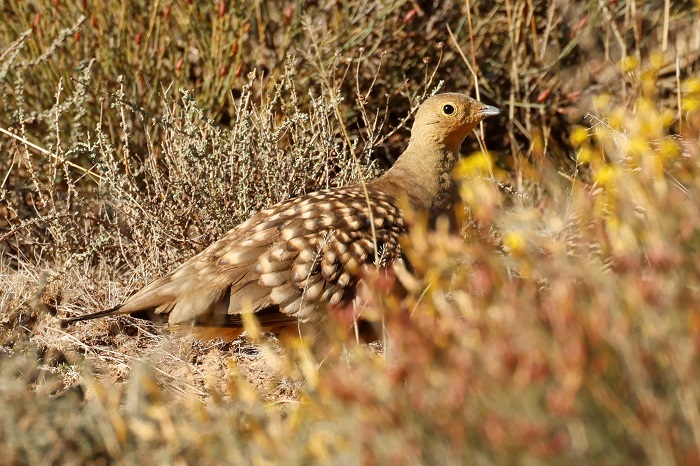Cover image: Namaqua Sandgrouse by Tino Herselman – Middelburg, Eastern Cape – BirdPix No. 264328
Identification
Sandgrous are short-legged terrestrial birds with attractive plumage patterns. They somewhat resemble pigeons but are more closely related to wading birds.

Lemoenfontein Game Lodge, Western Cape
Photo by Gerald Wingate
The Namaqua Sandgrouse is sexually dimorphic in terms of plumage colouration. Males have a plain yellow-brown, unmarked head and neck area, extending down to the lower breast. The face and throat have a buffy orange wash and there is a narrow, yellow ring of bare skin around the eye. There are two bands across the lower breast, the top band is white while the lower band is dark purplish-brown. The belly is dark greyish-brown and unmarked. The back and folded wings are dark brown with beautiful buffy-yellow and blue-grey spots.
Females are buffy-yellow overall with intricate black-brown barring, streaks and mottling over the whole body. The upper breast shows vertical streaking that changes to horizontal barring on the lower breast and belly.

Pofadder district, Northern Cape
Photo by Cobus Elstadt
Juveniles resemble females but are more rufous above with some white-tipped feathers.
In flight the Namaqua Sandgrouse shows a relatively long and narrow pointed tail. This is diagnostic as all other southern African sandgrouse species have shorter, more broadly pointed tails.

Carnarvon district, Northern Cape
Photo by Rick Nuttall
The Namaqua Sandgrouse may be mistaken for other sandgrouse species. The female lacks the chestnut belly of female Yellow-throated Sandgrouse (Pterocles gutturalis), and the female Double-banded Sandgrouse (Pterocles bicinctus) has barring (not streaks) on the upper breast. Males are best distinguished from the male Double-banded Sandgrouse by its plain yellowish-brown head which lacks the latter’s black crown streaks and black and white forehead bands.

Carnarvon district, Northern Cape
Photo by Ryan Tippett
Distribution
The Namaqua Sandgrouse is a common nomad and partial migrant. It is near-endemic to southern Africa and well adapted to life in arid regions. It occurs from extreme south-western Angola to Namibia, Botswana and western South Africa, from the west coast to the eastern Free State and Eastern Cape interior, and as far south as the wheatlands of the south Western Cape. It is a Vagrant to Zimbabwe, Lesotho, KwaZulu-Natal and the Eastern Cape coastal regions. The Namaqua Sandgrouse has population centres in the Karoo, southern Kalahari and the Etosha depression in Namibia.

Habitat
The Namaqua Sandgrouse inhabits open stone and gravel desert and semi-desert with a sparse scattering of low shrubs or grass tufts. Often favours drainage lines where food is more abundant and shade may be found during the heat of the day. Sometimes also inhabits arid, sandy savanna with denser vegetation, but generally where the average rainfall is less than 300mm.

Photo by Ryan Tippett
Behaviour
The Namaqua Sandgrouse is a gregarious species that is most often found in small flocks and in pairs during the breeding season.

Kgalagadi Transfrontier Park, Northern Cape
Photo by Marius Meiring
Spends the majority of its time on the ground, moving about with a shuffling gait on short legs.
Forages mostly during early morning and late afternoon and rests up in the shade of a bush during the midday heat. Crouches when disturbed, flushing suddenly before flying fast and straight.

Black Mountain Conservation Area, Northern Cape
Photo by John Cox
Drinks water daily with large aggregations forming at suitable water sources. Mostly visits water a couple hours after sunrise with smaller numbers arriving to drink in the late afternoon. Flocks may travel up to 60 km each day to visit water. They fly quite fast with an estimated cruising speed of 60-70 km/hr. They prefer exposed water holes with little surrounding vegetation, and are able to drink fairly saline water but prefer fresh water when available. Sandgrouse are equipped with a salt gland to remove excess salt from their bodies. They are unable to perch, so cannot drink from troughs or reservoirs, unless they are leaking.

Van Zylsrus district, Northern Cape
Photo by Kyle Finn
Flocks roost in stony areas and at the roost site, each bird makes a shallow roosting scrape in which it spends the night. Roosting birds huddle tightly together in cold weather, with adjacent birds facing alternate directions. Dustbathes frequently, but never bathes in water.
Forages during daylight, singly, in pairs or in small groups. Walks slowly with a crouched posture and with the head bent low, making quick pecks at the ground. Does not scratch with the feet, but will flick sand with its bill. Feeds almost exclusively on seeds, mostly small, hard seeds of ephemeral plants, with occasional fresh leaves, flowers and small fruits. Prefers protein-rich legume seeds. Seldom consumes seeds of grasses and daisies. Gravel and pebbles are swallowed intentionally to assist in grinding up seeds in the gizzard.

Etosha National Park, Namibia
Photo by Zenobia van Dyk
Breeding is recorded in all months of the year except February with a peak during late winter and spring.
The nest is a simple scrape in the ground, usually exposed to the elements and placed close to a rock or grass tuft. 2 or 3 tawny coloured eggs with dark speckles are laid per clutch. Incubation duties are shared by both sexes and last for around 21 days. The strikingly patterned chicks usually hatch synchronously within 24 hours of each other. Hatchlings are precocial and are led away from the nest to feeding sites within 12 hours of the last chick hatching. Chicks self-feed within 24 hours, eating only seeds which are pointed out to them by the adults.

Lutzville district, Western Cape
Photo by Danny Kotze
Sandgrouse have specially adapted feathers on the belly and lower breast that absorb and hold water. Males, and less often females, carry water in these soaked belly feathers, from which chicks drink daily for about 2 months.
Further Resources
This species text is adapted from the first Southern African Bird Atlas Project (SABAP1), 1997.
The use of photographs by Cobus Elstadt, Danny Kotze, Gerald Wingate, John Cox, Karis Daniel, Kyle Finn, Marius Meiring, Rick Nuttall, Tino Herselman and Zenobia van Dyk is acknowledged.
Virtual Museum (BirdPix > Search VM > By Scientific or Common Name).
Other common names: Kelkiewyn (Afrikaans); Lekotokobii (Tswana); Namaqua-zandhoen (Dutch); Ganga namaqua (French); Namaflughuhn (German); Cortiçol da Namáqua (Portuguese).
Recommended citation format: Tippett RM 2023. Namaqua Sandgrouse Pterocles namaqua. Biodiversity and Development Institute. Available Online at https://thebdi.org/2023/10/20/namaqua-sandgrouse-pterocles-namaqua/

Karoo-Gariep Nature Reserve, Northern Cape
Photo by Karis Daniel

